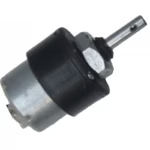2S 8A Li-ion 18650 Lithium battery protection board
SKU:
0834
₨ 200.00
In stock
In stock
20
People watching this product now!
Description
2S 7.4V 8A Li-ion 18650 Lithium Battery Charger Protection Board typically refers to a circuit designed to manage the charging and discharging of a 2-cell series (2S) lithium-ion battery pack, which is often made from 18650 cells. These types of protection boards are used in conjunction with a charger to ensure safe operation of the battery pack, protecting it from overcharging, overdischarging, and overcurrent conditions.
Here are the typical specifications for such a 2S 7.4V 8A Li-ion 18650 Battery Charger Protection Board (8.4V):
General Specifications:
- Battery Configuration: 2S (2 cells in series)
- Nominal Voltage: 7.4V (3.7V nominal per cell)
- Full Charge Voltage: 8.4V (4.2V per cell)
- Discharge Cut-off Voltage: Typically 6.0V to 6.4V (3.0V to 3.2V per cell)
- Maximum Charging Voltage: 8.4V (4.2V per cell)
- Charging Current: Typically up to 2A to 3A (depends on charger design, though 8A would typically not be supported by the protection board)
- Discharge Current: 8A peak (continuous discharge current will often be less, typically 5A-6A)
- Operating Temperature Range: Typically from -20°C to 60°C
- Charging Voltage Cut-off: 8.4V (±0.05V) for complete charge
- Low Voltage Cut-off (Undervoltage Protection): Usually around 6.0V to 6.4V (3.0V to 3.2V per cell)
Protection Features:
-
Overvoltage Protection:
- Prevents the battery from being overcharged above 4.2V per cell (8.4V total for the pack).
- Cut-off voltage is generally around 8.4V for a 2S pack.
-
Undervoltage Protection:
- Protects the battery from discharging too far below safe limits. The cutoff for discharge is usually around 6.0V to 6.4V (3.0V to 3.2V per cell).
-
Overcurrent Protection:
- Protects the battery and the protection circuit from excessive current.
- Peak current protection can typically go up to 8A for short bursts, but continuous current is usually around 5A to 6A depending on the BMS.
-
Short-Circuit Protection:
- Automatically disconnects the battery in the event of a short circuit to prevent potential damage to the cells or the protection board.
-
Overtemperature Protection:
- Monitors the temperature of the battery pack and disconnects the load or charger if the temperature exceeds a safe threshold, typically around 60°C to 70°C.
-
Cell Balancing:
- Some protection boards include passive balancing to ensure that both cells in the series configuration maintain equal charge levels, improving battery lifespan and performance.
- In most cases, however, balancing is less critical for small, low-power systems but becomes essential for larger setups.
Charging and Discharging Characteristics:
- Charging Voltage:
- 8.4V for a 2S configuration (4.2V per cell), and the charger used must be designed for this specific voltage.
- Charging Current:
- Typically 2A to 3A is common for 18650-based boards.
- Discharge Cutoff:
- The protection circuit will disconnect the load when the voltage drops below 6.0V to 6.4V, typically around 3.0V per cell.
Physical Characteristics:
- PCB Dimensions: Typically compact, designed to fit into small battery packs. Dimensions might be around 40mm x 50mm (varies by manufacturer).
- Weight: Lightweight, typically around 10-20 grams, depending on the size and design.
- Connector Type:
- JST or XT60 connectors for connecting to the battery pack.
- 3-pin or 4-pin for the charging port, depending on the board configuration.





